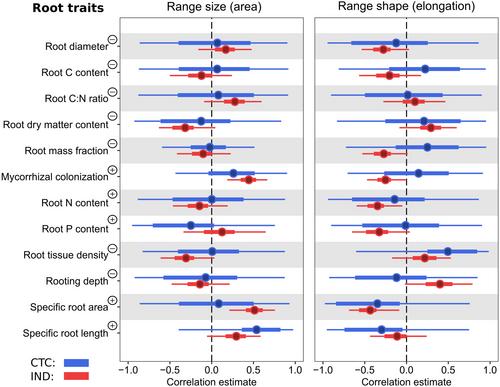Plant functional traits are frequently proposed as influential factors in species distribution. However, there is a gap in assessing how plant resource-economic traits relate to the size and shape of a species' geographical range, and to what extent these relationships are conserved over evolutionary history. Specifically, an acquisitive strategy (characterized by heightened metabolism, shorter lifespan and quicker generation turnover) may promote isotropic range formations, resulting in less elongated and larger ranges. Here, I tested this link using data from 98 native European tree species.
Palaearctic.
Present.
Trees.
I used chorological maps to quantify two independent range attributes: species' range area and elongation. I considered 28 functional traits linked to resource-use strategy measured in above- and below-ground organs. I used multi-response phylogenetic mixed models to calculate the conservative trait correlation (CTC) and the phylogenetically independent correlation (IND) component of each functional trait with range area and elongation.
Range area positively correlated with resource acquisitive strategies, while range elongation correlated with resource conservative strategies. This pattern was consistent across the examined traits but statistically significant in seven out of the 28 traits, including specific leaf area, specific root area and root mycorrhizal colonization. Traits related to leaf and root nutritional status exhibited the weakest relationships with range attributes. Significant correlations were more frequent in the IND component and often showed contrasting trends compared to CTC.
Plant resource-use strategy emerges as a relevant factor to gain insights on what shapes species' geographical distribution, alongside more established drivers such as dispersal limitation and climatic tolerance. Trait-range relationships are driven by processes leaving a weak phylogenetic signature. These processes may result from direct selection, where functional traits impact range attributes, or indirect effects, such as the co-variation of ranges and traits with environmental niche optima.



